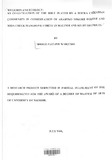| dc.description.abstract | Environmental degradation is one of the global challenges that are heavily attributed to the rapid advance in science and technology.
Kenya as a developing country faces a number of environmental challenges. This includes soil and water pollution especially through the use of polythene bags, air pollution and deforestation.
This study is based on the contribution of a Christian organization under the umbrella of A Rocha Kenya that has tried to solve the problem of environmental degradation in two major ecosystems namely; (i) Arabuko-Sokoke forest found in parts ofKilifi and Malindi Disrticts.
Arabuko -Sokoke forest covers an area of 420km2 and comprises of the remnant of Dry Coastal Forest that once stretched from South Somalia to Mozambique.
However of late, the neighbouring community has over exploited the resources within the forest. This is mainly through felling trees for charcoal extraction, woodcarving, and timber for both domestic and commercial use.
Currently, two indigenous trees (Muhuhu and Murihi) are at the verge of extinction. (ii) Mida creek Mangrove forest is an important breeding zone for fish and a stop over for migrating birds. This ecosystem is also threatened through cutting down of trees for both domestic and commercial purposes.
This study therefore, seeks to examine the role played by Christian's organization in general and in particular by the local Christian community in conservation of Arabuko- Sokoke and Mida Creek mangrove forests; Through: - a forestation, reforestation and Agro forestry. In addition, the study looks at the steps taken by the Christian community in order to provide sustainable livelihoods that bring ease to cheap livelihoods that result into environmental degradation.
The study' hypothesis are; The destruction of Arabuko Sokoke and Mida creek mangrove forests is as a result of need for timber for both commercial and domestic purposes.
Poverty is both a cause and effect of environmental degradation in Mida Creek and Arabuko Sokoke forests. The study's theoretical framework is delivered from Peter Harris book under the bright wings. In this book J. Scott argues that ecological involvement falls under the heading of Christian Mission since Christian Mission embraces everything since, Christ sent people to the world to do service as well as evangelism. Therefore Christians cannot claim to engage in social service if at all they are destroying the environment in which they and
their neighbors live. Information related to this study was gathered through personal interviews, participant
observation questionnaires and literature received from A Rocha Kenya. The data collected, has revealed that human activities as a result of population growth is putting pressure on the environment resulting into degradation of the coastal dry forests, mangrove forests and land, water and marine ecosystems.
However, the umbrella cause of environmental degradation is poverty that has led to use of cheap livelihoods such as charcoal burning that cause great strain to the environment since they are not sustain ably harvested. In connection to poverty, this study has realized that is difficult to win the battle of environmental degradation in a community faced by poverty especially when the community for so long has depended upon the natural resources surrounding them for survival.
The implication of this is that: firstly, its is of great importance to strike a balance between conservation of natural resources and harvesting of the same resources by initiating sustainable social economic development projects that will provide alternative means of survival and ease pressure on the two forest ecosystems. Secondly, there is important for A Rocha - Kenya, Churches III Kilifi and Malindi Districts KWS, Forest Department and other stakeholders involved in conservation and preservation of Mida Creek and Arabuko Sokoke to put more emphasis on comprehensive community participation both in environmental conservation and sustainable development projects with a lot of emphasis to the youth. This will avoid the feeling of alienation and lack of accountability by the local communities especially with the squatters who may not consider themselves as accountable to both conservation and development of the pieces ofland they are currently occupying.
Thirdly, Environmental degradation and poverty are intertwined whereby poverty becomes a cause and effect of environmental degradation. This is because all organisms draw from the environment things they need for survival. Human beings place the largest demand on the environment and where poverty levels are high a lot of reliance is placed on the environment. Therefore, for total rehabilitation of the two forests ecosystem in a scenario of alarming population growth and sky rocketing demands for the natural resources there is need for more emphasis to be laid on reforestation, a forestation, and Agro forestry campaigns. | en |

